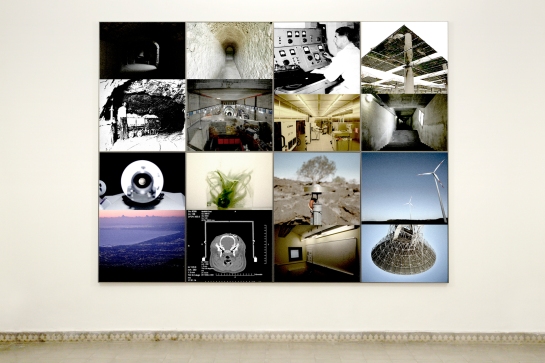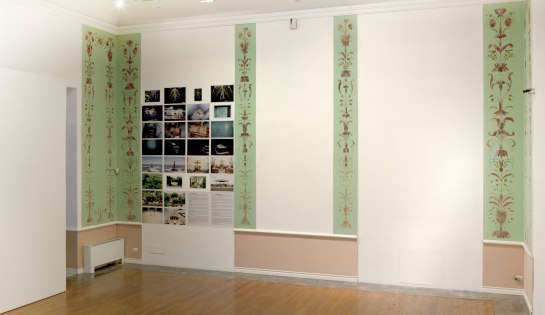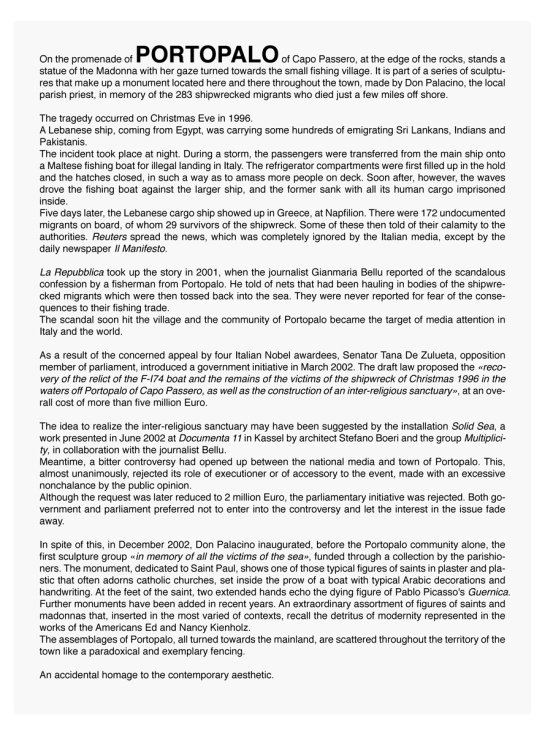Silver Bars (in Brimstone), documentary movie, 16:9 SD 64’, 2007-08.
BdA, photographic series, Durst Lambda prints on metal paper on Dibond panels with aluminium frames and museum glass, each dimension cm. 115×76,5, 2008.
Building a Science Museum in a disused sulphur refinery in the old industrial area of Catania may be an opportunity for a journey into the modern history of eastern Sicily. Indeed, the sulphur mines exploitation, which started in the early nineteenth century, immediately linked Sicily to the industrialization process that was spreading from England in Europe and America.

BdA7793779888678340076479260861876386068786882784608474
Installation view from the exhibition DA QUI # 01.09, gianluca collica gallery, Catania 2009.
BdA (Barre d’Argento – Silver Bars) is an acronym chosen to indicate two different works, which were intended to complete the exhibition contents of the Science Museum of Catania, and which purpose was to illustrate the recent history of the development in Sicily. The title was inspired by a work of the American artist Lawrence Weiner, which was realized in Catania at the gianluca collica gallery, the statement Silver Bars Bathed in Brimstone.
The documentary movie Silver Bars (in Brimstone) and the photographic installation BdA7793… are far-reaching journeys telling a story that goes from the sulphur years to those of oil and developers, up until the technological district and the numerous scientific research programmes that have developed around the Department of Physics of Catania. A journey from the bowels of the world to the top of volcano. It’s a laborious ascension to the vastness of the sea and the sky, from Inferno to Paradise. Furthermore, the two BdA works both represent an attempt to reconcile the experimental fury of the art in 1900 with a – often unevenly – communicator function of the work of art.
The narration of Silver Bars (in Brimstone) links the protagonists’ testimonies (from miners, owners of the deposits, scientists) and the historians’ interviews, with extracts of Sicilian literature (Luigi Pirandello, Giovanni Verga, Enzo Di Bernardo, Melissa Panarello). Locations views from the Floristella mine to the Priolo petrochemical centre, from the commercial centre (designed by the Italian archistar Massimiliano Fucksas) to the nuclear accelerator at the university campus, alternate with film excerpts of Italian documentary masterpieces such as Surfarara by Vittorio De Seta, Col cuore fermo Sicilia by Gianfranco Mingozzi, Gela antica e nuova by Giuseppe Ferrara, or with archival footage of scientific experiments.
Eight (plus two) panels make the photographic installation; each one is the combination of two photographs. This combination of two creates a reciprocal relationship. On one hand, we have a dialectic regarding the subject contents of the photos. On the other, there are two portions of space that confront each other for the purely formal aspect of the composition. In each panel each photo, or portion of space, communicates with the other but also with those making the remaining seven panels. Each area represents also a place or a matter: cave, sea, sky or earth, air, water, fire, or sea, mountain/volcano, sun.
Landscape, thus, works as a narrative of a (hi)story. The structure of the photo installation, then, aims to replace specific formal, thus ideological, references of modernism.
[Federico Baronello, a written report to Helmut Friedel after the work’s acquisition by the Städtische Galerie im Lenbachhaus, München, Oct. 2009]

BdA7793notitle Underground of the Palazzo Pennisi Floristella, Valguarnera and archival photo of the Trabonella mine, Caltanissetta.

BdA_notitle8340 The founder of the Nuclear Physics in Catania and the Clean Room at the Institute for Microelectronics and Microsystems – CNR, Catania.

BdA_77988867 Underground of the Palazzo Pennisi Floristella, Valguarnera and 15MeV nuclear accelerator at the INFN – Laboratories of South, Catania.

BdA_07647926 The disused ENEL Solar Central of Adrano and the INGV underground shelter at Pizzi Deneri, Mount Etna.

BdA_8606notitle Pineapple into a Growth Room and a TAC photo-still of the head of a pig for the positioning of a robotic arm during an experiment of neurosurgery.

BdA_87868827 Antenna for GPS monitoring of Etna’s volcanic soils and the NEMO’s data analysis laboratory at the port of Catania.

BdA_08618763 A view of the moon from INAF at Serra la Nave, Mount Etna and the conurbation of eastern Sicily seen from Rifugio Sapienza, Mount Etna.

BdA_84608474 The Francofonte wind farm and the INAF-IRA radio telescope, Noto.

BdA_87038587 A De Chirico Italian Piazza and the underground parking lot at Etnapolis, a shopping mall designed by Massimiliano Fuksas.

BdA_88558847 Corridors and the CHIMERA particle detection apparatus at the INFN – Laboratories of South, Catania.














































